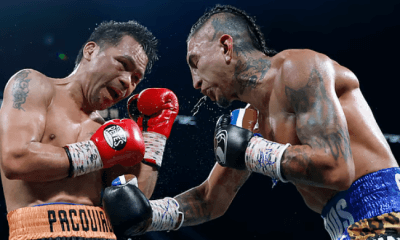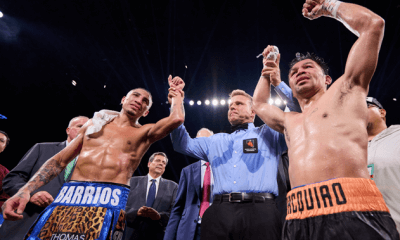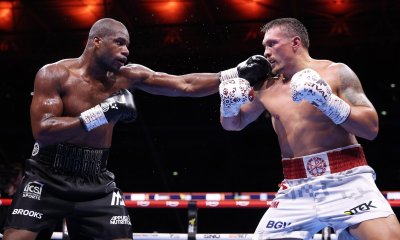Articles of 2006
Devon Cormack, Kickboxing World Champion and Boxing Trainer
Devon Cormack is one of the best American kickboxers of the last few years. He won titles in three weight divisions for many different organizations and built a solid connection with the boxing world. In order to improve his hand techniques, he trained at Gleason’s Gym and later became a boxing coach himself. Among others, Cormack trained his own sister, Alicia Ashley, who had started as a kickboxer. Devon convinced her to try a career in boxing and eventually became her manager. It paid off. Alicia won two world titles. I met Devon Cormack during my last visit at Gleason’s and asked him about his career and the current situation of kickboxing in the United States.
Devon, when did you get involved in kickboxing?
When I was a karate student. My style was kyokushin, the toughest in the world. Everybody knows that in karate competitions full contact is illegal, not in kyokushin. Even in the 1970s, kyokushin fighters delivered punches and kicks at full power with the intention of knocking out their opponents. I got charmed by kyokushin for the spectacularity of its kicks. Later, I understood that I could use those kicks to win kickboxing matches and I decided to become a kickboxer. I went to Gleason’s Gym to improve my punching ability, trained with Hector Roca who taught me a lot about the proper way to throw and avoid punches. I became pretty good in boxing, but I’m more famous for the effectiveness of my kicks which are also very spectacular. In the kickboxing ring, they call me “The Energizer.”
When you say kickboxing, you mean the style without low kicks?
Yes, because it’s the style more appreciated by promoters and fans in America. I live in New York, so I adapted to U.S. rules. By the way, my low kicks are great. I could score a knockout if I used them in the ring. I learned low kicks through kyokushin.
What’s your kickboxing record?
My record is 18 wins, 2 losses and 1 draw. I won many belts, in three weight divisions. I have been USKBA world featherweight champion, KICK world super bantamweight champion, ISKA world bantamweight champion, ISKA United States super bantamweight champion. Usually, my weight is 119 pounds and that makes me a bantam in many organizations.
Where did your biggest fights took place?
In major U.S. arenas, like the Trump Taj Mahal and the Tropicana. Both those cards in Atlantic City were sold out. At the Tropicana, I remember many people watching the fights standing up. I also fought in New York, in the ballroom at the Crown Plaza Hotel. My fights were broadcasted by MSG Network and ESPN.
Did you fight exclusively in the Unites States?
No, I also fought in Ukraine where I defeated on points Boris Gryshin. I went there in 1999 with an American team to face the best local kickboxers. Three cards were staged in three cities on November 4, 7 and 10. A total of 30,000 spectators attended those shows. It was a great experience.
When did you decide to became a boxing trainer?
While training with Hector Roca, I became always more involved in boxing. I understood that my new boxing skills helped me a lot winning kickboxing matches. Becoming a boxing trainer was the next step. I decided to give it a try, it worked, and Bruce Silvergrade offered me a job in his gym. I train kickboxers who want to improve their punches, but also professional boxers and average people. Right now, one of my students is a young woman with college education whose goal is to work at the United Nations. You won’t believe it, but she also wants to compete in the Golden Gloves! She is pretty good and I think she will get far in that tournament. One of the girls I train won the Golden Golves in the 106 pounds division. I also work as a manager for my sister Alicia Ashley. The beginning of her boxing career wasn’t easy and she got a few losses, but she kept on improving and became IWBF world champion in the super bantamweight and featherweight divisions. Her record is 12 wins (1 KO), 6 losses and 1 draw. I’m very proud of her.
How do you judge the boxing skills of the American kickboxers?
American kickboxers can definitely use their hands. They start the boxing program for the same reason I did: to be able to punch more effectively. At the beginning of my kickboxing career, I tried to get a KO with my kicks and didn’t throw too many punches. I didn’t even think of hitting the body many times. When I threw a punch to the chest, it seemed to have little effect. After my boxing training was over, I scored many KOs thanks to my punches. I learned how to deliver damage to my opponent’s body and then finish him off with a punch to the face. I teach all this to my students. Even if they ask me to work only on their kickboxing skills, I tell them that the first step is to learn boxing.
Speaking of your students, do you use the same training schedule for men and women?
The training schedule is the same, but the approach changes. I don’t make a difference between men and women, but among persons with different characters. Some people are very timid and must be approched in a soft way. Others are very aggressive and want me to be the same. If I tell them to just hit the bag, they complain that I’m not stimulating them so I yell: “Hit the f-ing bag.” This makes them feel in a fight gym atmosphere, which they like.
Tell us about the current status of kickboxing in the United States.
If we talk about fighters and shows, kickboxing is healthy. There are excellent fighters around and most shows draw thousands of paying customers. The problem is that kickboxers make no money, even the champions. They start getting $100 per round, just like boxers. The difference is that boxers regularly improve their purses. Even the ones who complain about getting small amount of money, are making at least $50,000 for a world title match. In kickboxing, the purse for a world title can be from $2,400 to $7,000. That’s really a small amount of money. If you think about it, $2,400 for a 12 rounds fight, is $200 per round. So a kickboxer starts with $100 per round and ends up to $200 per round. That’s ridiculous. Even in Atlantic City, where they have the real money and could pay better, the situation is the same. If a kickboxer says that he is not gonna fight for less than $50,000, nobody will call him again.
The main kickboxing organizations in the United States is the World Kickboxing Association. It is famous all over the world, because so many legendary kickboxers won its titles. Right now, over 90 countries are associated with the WKA. The U.S. branch complains in its website that there aren’t enough American kickboxers in the world rankings and that “the mission of WKA-USA to restore U.S. kickboxers to their rightful place and prestige within the WKA and support and promote U.S. fighters competing for world titles.
The International Sport Kickboxing Association is another very famous organization. On its website, ISKA claims about “sanctioning over 200 major title kickboxing events per year on five continents.”
The United States Kickboxing Association is based in New Jersey. Not many people know the USKBA in Europe.
International Kickboxing Federation’s main office is in California. The IKF has representatives in Europe and Asia.
-

 Featured Articles3 weeks ago
Featured Articles3 weeks agoThe Hauser Report: Zayas-Garcia, Pacquiao, Usyk, and the NYSAC
-

 Featured Articles2 weeks ago
Featured Articles2 weeks agoOscar Duarte and Regis Prograis Prevail on an Action-Packed Fight Card in Chicago
-

 Featured Articles1 week ago
Featured Articles1 week agoThe Hauser Report: Cinematic and Literary Notes
-

 Book Review5 days ago
Book Review5 days agoMark Kriegel’s New Book About Mike Tyson is a Must-Read
-

 Featured Articles4 weeks ago
Featured Articles4 weeks agoManny Pacquiao and Mario Barrios Fight to a Draw; Fundora stops Tim Tszyu
-

 Featured Articles4 weeks ago
Featured Articles4 weeks agoArne’s Almanac: Pacquiao-Barrios Redux
-

 Featured Articles3 weeks ago
Featured Articles3 weeks agoRemembering Dwight Muhammad Qawi (1953-2025) and his Triumphant Return to Prison
-

 Featured Articles4 weeks ago
Featured Articles4 weeks agoOleksandr Usyk Continues to Amaze; KOs Daniel Dubois in 5 One-Sided Rounds













